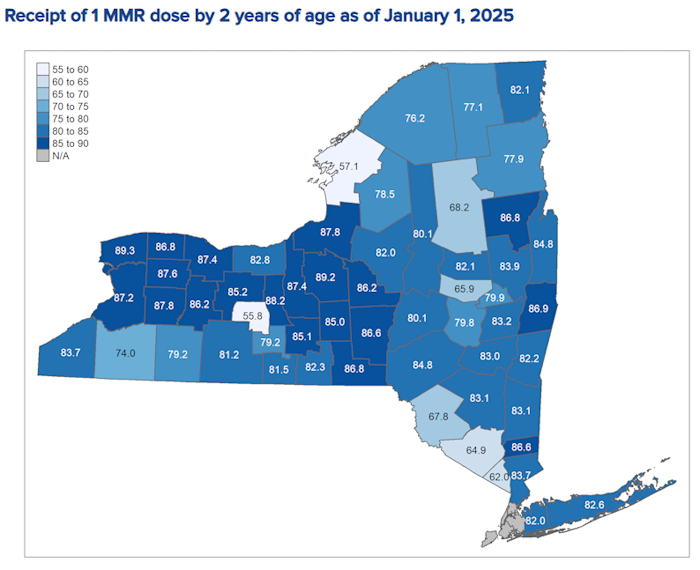Infections nationwide top 1,000; most in Texas
The U.S. surpassed 1,000 measles cases on Friday (May 9), including three cases reported this week in Orange County.
Texas still accounts for most cases, with 709 confirmed in an outbreak that has spread to New Mexico, Oklahoma and Kansas. Two unvaccinated elementary school children died in West Texas, along with unvaccinated adult in New Mexico.
Other states with outbreaks — which the federal Centers for Disease Control and Prevention defines as three or more related cases — include Indiana, Michigan, Montana, Ohio, Pennsylvania and Tennessee. New York has confirmed seven cases, including three in New York City, one on Long Island and the three in Orange County.
The state Department of Health said the Orange County cases involve children younger than 5 years old who recently traveled internationally. No exposures outside immediate family members are known, it said.
Orange County Deputy Health Commissioner Lisa Lahiff told the Times Union that because the cases were reported to the local health department in close succession, “we believe this is not indicative of local transmission.” Officials declined to say whether the children were vaccinated, citing patient privacy.
Earlier this year, the state Department of Health reported that Orange County has the lowest first-dose measles vaccination rate among 2-year-olds in the region, at 64.9 percent. A rate of at least 95 percent is needed to provide “herd immunity.” The Putnam County rate is 86.6 percent and the Dutchess rate is 83.1 percent.

The first of two vaccine shots is recommended between 12 and 15 months old and the second between 4 and 6 years old.
Measles is caused by a highly contagious virus that’s airborne and spreads easily when an infected person breathes, sneezes or coughs.
As the virus takes hold in U.S. communities with low vaccination rates, health experts fear that spread could stretch on for a year. In 2019, the U.S. had 1,274 cases and almost lost its status of having eliminated measles.
Getting another MMR shot as an adult is harmless if there are concerns about waning immunity, the CDC says. People who have documentation of receiving a live measles vaccine in the 1960s don’t need to be revaccinated, but people who were immunized before 1968 with an ineffective vaccine made from “killed” virus should be revaccinated with at least one dose, the agency said.
People who have documentation that they had measles are immune, and those born before 1957 generally don’t need the shots because so many children got measles back then that they have “presumptive immunity.”
Measles infects the respiratory tract, then spreads through the body, causing a high fever, runny nose, cough, red, watery eyes and a rash. The rash generally appears three to five days after the first symptoms, beginning as flat red spots on the face and spreading downward to the neck, trunk, arms, legs and feet. When the rash appears, the fever may spike over 104 degrees, according to the CDC.
Most children will recover, but the infection can lead to dangerous complications such as pneumonia, blindness, brain swelling and death. There’s no specific treatment, so doctors try to alleviate symptoms, prevent complications and keep patients comfortable.

